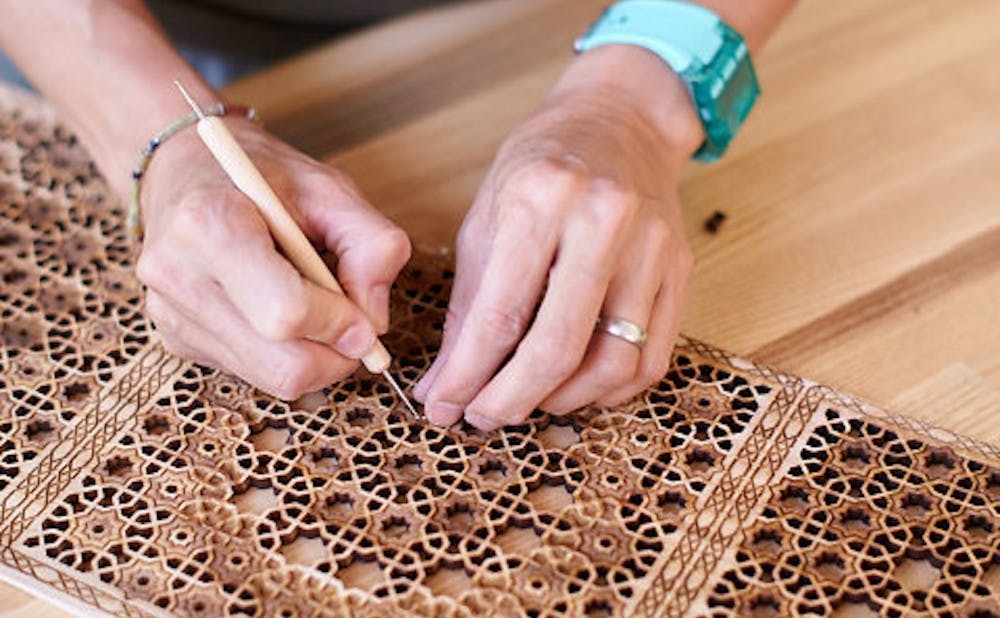Migration — whether it be across the U.S.-Mexico border, among states in the European Union or from Africa into Europe — is a topic that is fraught with political tension. The justifications for migration, as well as the rallying cries against it, are embedded in familiar issues ranging from colonialism and capitalism to xenophobia and elitism.
In “Cornered,” a video installation at the Rubenstein Arts Center through Oct. 21, Visual and Media Studies professor Raquel Salvatella de Prada aims to strip the political layer away from a rarely discussed migratory issue: the continuous, determined efforts of African immigrants to cross the highly-fortified border wall of Morocco into the Spanish cities of Ceuta and Melilla and claim asylum status in Europe. Salvatella de Prada created the installation knowing that few viewers would have prior knowledge of this complex issue. She focuses on the lived experiences of these migrants, translating their frustration and determination into visual form. Her installation thereby isolates the humanity of the migrants and simultaneously attempts to call into consciousness the humanity of the viewer.
“I wanted to make the installation in such a way that you didn’t know that [African migration] was the topic,” Salvatella de Prada said. “I wanted the viewer to get immersed by the culture and the beauty of their being human, rather than seeing them as something that’s dangerous to your country.”
The installation is best described as a cylindrical structure modeled according to a traditional Moroccan table, with a dome made of silk situated on top. Slats crisscross the dome, dividing it into rhomboids and triangles. A video is projected onto the surface of the dome, which displays black silhouettes dancing beneath the slats. The cylindrical table is decorated with delicate, perforated geometric designs, from which yellow light is emitted. The installation as whole stands within a dark room, so the light coming from the projection and from within the table bounces off the walls. Overall, it’s a captivating, engaging and immersive experience.
Preparation for creating the installation involved an immense amount of precision and forethought. Salvatella de Prada first came up with the idea for the installation back in 2014, when she encountered a striking photo of migrants perched atop the fortified border fence, their anonymous silhouettes the only identifiable features. The idea for silhouettes would later become central to her installation, as she injected them with emotion and rigour via dance in order to underscore the shared humanity of migrants. But with the Syrian refugee crisis increasingly commanding attention in the media, the project was put on the back burner until 2016. It was only after seeing M.C. Escher’s Alhambra-inspired work that Salvatella de Prada decided to return to the project, utilizing precise calculations to create a work inspired by geometric Islamic architecture that could simultaneously project a video of emotive dancers before a shifting, fluid background.
To enrich her work even further, Salvatella de Prada traveled to Melilla and spoke with migrants who had successfully crossed the border wall as well as employees of nongovernmental organizations that helped route migrants to mainland Spain. She also visited the Nadar, Morocco, which is situated beside the forests where migrants camp in preparation for their jumps. There she spoke to priests that provided limited shelter and medical care to migrants who had been injured or beaten during the jumps. Her trip permitted her a more comprehensive view of an issue she had only heard about through news articles and videos, allowing her to parse between the “human” and the purely “political”.
The care with which Salvatella de Prada crafted and conceived her installation is evident in the work itself. The audio accompanying the installation is bookended with sounds of the forest, and the colors displayed on the projection follow the course of a day, from bright blues to the deep reds and oranges of sunset. As the 8-minute projection and audio repeat themselves, it becomes clear that the installation mirrors the experiences of the migrants, who day after day make repeated attempts to scale the border wall in the hopes of attaining a better life.
“I feel like the music goes up and down in its feelings and emotions, which is what is happening to these people,” Salvatella de Prada said. “Over and over, they try to make the crossing, and often they don’t make it, so they return to the forest ... and they try it again, and again, and again. The pattern of the music reflects the journey of the sub Saharan Africans.”
Both the movement of the dancing silhouettes and the audio — which consists of a passionate oration in the Manding language and a vibrant track inspired by North African music — help strip this migratory issue down to its emotional components. With the dancers separated from identity and the audio untranslated, the viewer is left with an affecting impression of determination, deliberateness and frustration.
The exhibit is part of the inTransit series, an interdisciplinary humanities project run by Duke faculty and students from the Romance Studies and Art, Art History & Visual Studies departments.
“Cornered” is a poignant portrayal of the migrant experience made with great care and passion. It attempts to enrich our knowledge of migratory issues through a contextual and artistic lens with the implicit assertion that discussions of migration are not purely objective. At their heart, they are subjective, and therefore their emotions must be treated with care.
Get The Chronicle straight to your inbox
Signup for our weekly newsletter. Cancel at any time.

